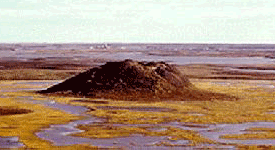
What is a Pingo?
Pingo is an Inuit (Northern Eskimo) word meaning hill. The term was borrowed in 1938 by Danish botanist, Alf Erling Porsild, to describe a specific kind of hill: a rounded or conical hill having an ice core, and only found in regions with permafrost (permanently frozen soils). Even in permafrost areas there is an active top layer of soil that thaws during the summer and refreezes each winter. Beneath rivers and lakes thaw bulbs of unfrozen ground form that can stay thawed even in winter. |
 Ibyuk Pingo, NWT, Cananda - Source: Helen Kerfoot, NRC |
The most common pingos form in the saturated soils of alluvial deltas where lakes
|